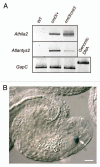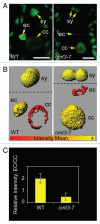A role for CHROMOMETHYLASE3 in mediating transposon and euchromatin silencing during egg cell reprogramming in Arabidopsis
- PMID: 20505370
- PMCID: PMC3115342
- DOI: 10.4161/psb.5.10.11905
A role for CHROMOMETHYLASE3 in mediating transposon and euchromatin silencing during egg cell reprogramming in Arabidopsis
Abstract
During embryogenesis there is a major switch from dependence upon maternally-deposited products to reliance on products of the zygotic genome. In animals, this so-called maternal-to-zygotic transition occurs following a period of transcriptional quiescence. Recently, we have shown that the early embryo in Arabidopsis is also quiescent, a state inherited from the female gamete and linked to specific patterns of H3K9 dimethylation and TERMINAL FLOWER2 (TFL2) localization. We also demonstrated that CHROMOMETHYLASE 3 (CMT3) is required for H3K9 dimethylation in the egg cell and for normal embryogenesis during the first few divisions of the zygote. Subsequent analysis of CMT3 mutants points to a key role in egg cell reprogramming by controlling silencing in both transposon and euchromatic regions. A speculative model of the CMT3-induced egg cell silencing is presented here, based on these results and current data from the literature suggesting the potential involvement of small RNAs targeted to the egg cell, a process conceptually similar to the division of labor described in the male gametophyte for which we show that H3K9 modifications and TFL2 localization are reminiscent of the female gametophyte.
© 2010 Landes Bioscience
Figures




Similar articles
-
Dual histone H3 methylation marks at lysines 9 and 27 required for interaction with CHROMOMETHYLASE3.EMBO J. 2004 Oct 27;23(21):4286-96. doi: 10.1038/sj.emboj.7600430. Epub 2004 Sep 30. EMBO J. 2004. PMID: 15457214 Free PMC article.
-
Activation of Tag1 transposable elements in Arabidopsis dedifferentiating cells and their regulation by CHROMOMETHYLASE 3-mediated CHG methylation.Biochim Biophys Acta. 2016 Oct;1859(10):1289-98. doi: 10.1016/j.bbagrm.2016.07.012. Epub 2016 Jul 28. Biochim Biophys Acta. 2016. PMID: 27475038
-
Small RNAs prevent transcription-coupled loss of histone H3 lysine 9 methylation in Arabidopsis thaliana.PLoS Genet. 2011 Oct;7(10):e1002350. doi: 10.1371/journal.pgen.1002350. Epub 2011 Oct 27. PLoS Genet. 2011. PMID: 22046144 Free PMC article.
-
Silencing of transposons in plant genomes: kick them when they're down.Genome Biol. 2004;5(12):249. doi: 10.1186/gb-2004-5-12-249. Epub 2004 Nov 16. Genome Biol. 2004. PMID: 15575975 Free PMC article. Review.
-
Histone modification and the control of heterochromatic gene silencing in Drosophila.Chromosome Res. 2006;14(4):377-92. doi: 10.1007/s10577-006-1066-1. Chromosome Res. 2006. PMID: 16821134 Review.
Cited by
-
Pleiotropic phenotypes of the salt-tolerant and cytosine hypomethylated leafless inflorescence, evergreen dwarf and irregular leaf lamina mutants of Catharanthus roseus possessing Mendelian inheritance.J Genet. 2013 Dec;92(3):369-94. doi: 10.1007/s12041-013-0271-x. J Genet. 2013. PMID: 24371160
-
Chromatin dynamics during cellular differentiation in the female reproductive lineage of flowering plants.Plant J. 2015 Jul;83(1):160-76. doi: 10.1111/tpj.12890. Plant J. 2015. PMID: 26031902 Free PMC article. Review.
-
Pistil Transcriptome Analysis to Disclose Genes and Gene Products Related to Aposporous Apomixis in Hypericum perforatum L.Front Plant Sci. 2017 Feb 1;8:79. doi: 10.3389/fpls.2017.00079. eCollection 2017. Front Plant Sci. 2017. PMID: 28203244 Free PMC article.
-
Apomixis in plant reproduction: a novel perspective on an old dilemma.Plant Reprod. 2013 Sep;26(3):159-79. doi: 10.1007/s00497-013-0222-y. Epub 2013 Jul 14. Plant Reprod. 2013. PMID: 23852378 Free PMC article. Review.
-
Inactivation of a DNA methylation pathway in maize reproductive organs results in apomixis-like phenotypes.Plant Cell. 2010 Oct;22(10):3249-67. doi: 10.1105/tpc.109.072181. Epub 2010 Oct 29. Plant Cell. 2010. PMID: 21037104 Free PMC article.
References
-
- Baroux C, Autran D, Gillmor CS, Grimanelli D, Grossniklaus U. The maternal to zygotic transition in animals and plants. Cold Spring Harb Symp Quant Biol. 2008;73:89–100. - PubMed
-
- Seydoux G, Braun RE. Pathway to totipotency: lessons from germ cells. Cell. 2006;127:891–904. - PubMed
-
- Tompa R, McCallum CM, Delrow J, Henikoff JG, van Steensel B, Henikoff S. Genome-wide profiling of DNA methylation reveals transposon targets of CHROMOMETHYLASE3. Curr Biol. 2002;12:65–68. - PubMed
-
- Kato M, Miura A, Bender J, Jacobsen SE, Kakutani T. Role of CG and non-CG methylation in immobilization of transposons in Arabidopsis. Curr Biol. 2003;13:421–426. - PubMed
Publication types
MeSH terms
Substances
LinkOut - more resources
Full Text Sources
Molecular Biology Databases
